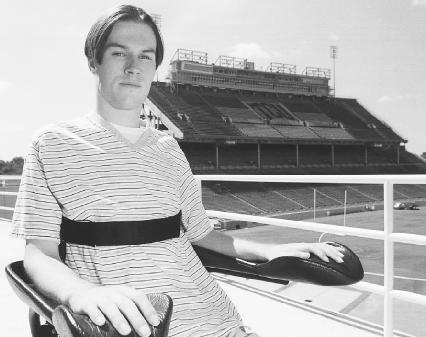Spinal Cord Injury - Symptoms
The symptoms of SCI depend on two factors: where the damage occurs and how serious it is. For example, damage below the T1 nerves causes loss

of feeling and paralysis in the legs and the lower body. The T1 nerves lie at the base of the ribs. Arm and upper body movement is not affected by this kind of injury.
Damage to nerves below the C3 level of nerves may cause loss of feeling and paralysis of the arms as well as the legs and upper body. The C3 nerves are located in the middle of the neck. This kind of injury may also damage a person's chest muscles, making breathing difficult, but not impossible.
Damage above the C3 level may cause loss of feeling and paralysis throughout the body below the neck. A person with this kind of damage is not able to breathe on his or her own.
A spinal transection causes complete loss of feeling and muscle control. A person is completely paralyzed in the part of the body below the injury. For example, a person whose spinal cord is severed at T1 will be unable to move his or her legs or the lower part of the body. If the spine is injured but not severed, some feeling may remain.
Spinal cord injuries can cause many other kinds of symptoms, including:
- Blood clots. Blood clots may form in veins when an arm or leg has been inactive for a long time. The clot may break loose and cause damage to the heart or lungs.
- Pressure ulcers. Pressure ulcers are sores that develop when a person can not move for long periods of time.
- Muscle stiffness. Spinal cord damage may make it impossible to move muscles normally. After a while, the muscles tend to become tight and shortened. This process is called a contracture. Eventually, the muscles become frozen in an abnormal and awkward position. When this happens, the muscle is said to be spastic.
- Calcium deposits in muscles and tendons. Spinal cord injury may cause the growth of bone-like material in muscles and tendons. This growth may produce swelling, redness, heat, and stiffness in a muscle.
- Failure of autonomic responses. Some body organs regulate themselves. The heart is an example. It automatically increases or decreases its rate of beating based on outside conditions, such as temperature. A person doesn't have to think about making these changes. They occur automatically. They are known as autonomic (self-controlling) responses. SCI can damage these systems. An organ may not respond the way it is supposed to. For example, pressure on the skin can cause organs to produce wild and uncontrolled responses. The patient may experience terrible headaches, nausea, anxiety, seating, and goose bumps. In extreme cases, these abnormal responses may lead to seizures, loss of consciousness, and even death.
- Loss of bladder and bowel control. Bladder and bowel control are maintained by the use of certain muscles. Young children have to learn how to use these muscles when they become toilet-trained. SCI can cause damage to the nerves that control these muscles. A person may urinate or defecate without wanting to, or may not be able to urinate or defecate when he or she needs to.
- Sexual dysfunction. Maintaining an erection requires control over muscles in the penis. If nerves are damaged, this control may not be possible. A man may not be able to have an erection. Sexual intercourse may become impossible. Women with spinal cord injuries, however may still be able to become pregnant, and can usually deliver a child with proper medical care.

Comment about this article, ask questions, or add new information about this topic: